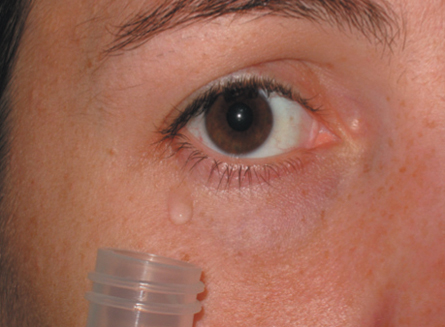Lonely teardrops
Just whiffing women's tears of sadness dampens men’s libido
Crying women may literally turn men off. Odorless chemical signals in a woman’s waterworks lessen any stirrings of sexual interest in a guy who whiffs her tear-stained cheeks, a new study suggests.

In a paper published online January 6 in Science, a team led by neuroscientists Shani Gelstein and Noam Sobel of the Weizmann Institute of Science in Rehovot, Israel, presents the first evidence that human tears contain pheromones, substances that influence behavior via smell. “Our experiments suggest that women’s emotional tears contain a chemosignal that reduces sexual arousal in men,” Sobel says.
Chemical compounds in tears that douse men’s desire have yet to be identified.
“This new report makes a strong case for pheromones in women’s tears, but the results clearly warrant replication,” comments neuroscientist Robert Provine of the University of Maryland Baltimore County.
The reasons why people, but not any other animal, cry at sad thoughts or events remain poorly understood. Tears provide key visual cues to a person’s inner emotional distress, Provine says. In a 2009 study that he directed, men and women rated the faces of crying people with visible tears as much sadder than the same faces digitally altered to remove tears. Tear removal made faces appear emotionally ambiguous, with participants saying that awe, concern or puzzlement often outweighed sadness.
In the new study, Gelstein and Sobel’s group had 24 men, ages 23 to 30, sniff a jar containing either tears collected from women as they watched sad film clips or drops of salt solution that had been trickled down the same women’s faces. A pad containing tears or a salt solution was then attached to each man’s upper lip as he rated the sadness and sexual attractiveness of images of women’s faces.
For 17 of 24 participants, female faces generally looked less sexually alluring after a man had just whiffed tears than after he’d sniffed a salt solution. Neither substance had a perceptible odor.
Another 50 men who sniffed women’s tears displayed physiological signs of reduced sexual arousal, such as a slow breathing rate and low salivary levels of the male sex hormone testosterone, relative to levels after sniffing a salt solution.
Finally, 16 men who sniffed women’s tears while watching a sad movie in a brain-scan machine displayed markedly lower blood-flow rates — a sign of reduced brain-cell activity — in areas that had previously reacted strongly to an erotic, R-rated movie. No sex-related brain drain appeared when these men sniffed a salt solution while watching a sad movie in a scanner.
There’s no way to know whether women evolved libido-squelching tears because they confer a survival or reproductive advantage of some kind, Provine says.
It’s an open question whether women’s tears of sadness contain other pheromones, Sobel notes. Further research should probe for chemical signals in men’s and children’s tears, he adds.
Men able to cry at a sad film in a lab are hard to find, so studies of men’s tears will proceed slowly, Sobel says. For now, women are belles of the bawl.






